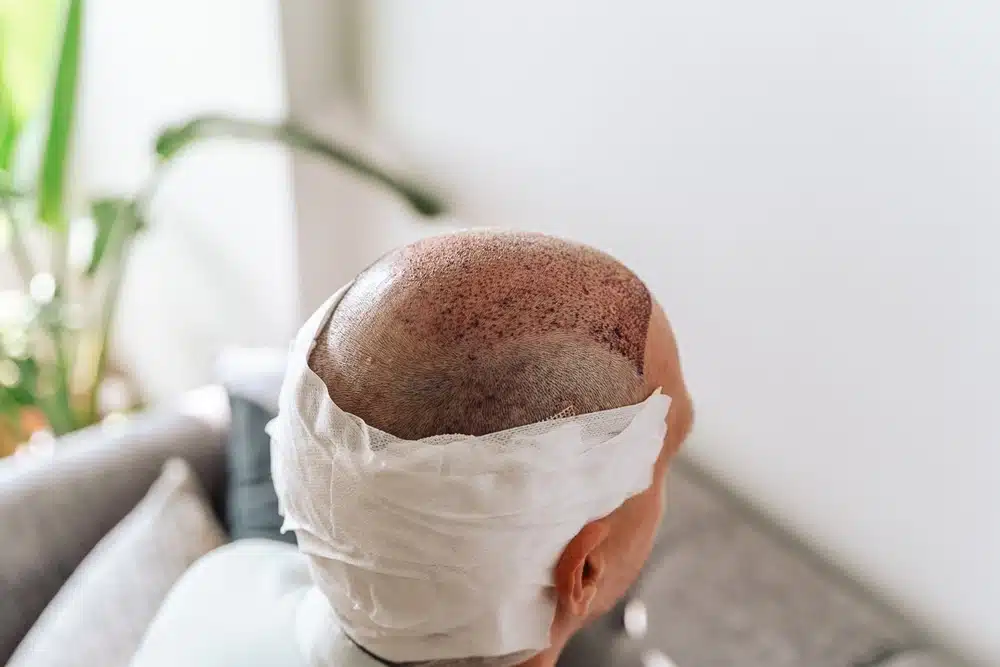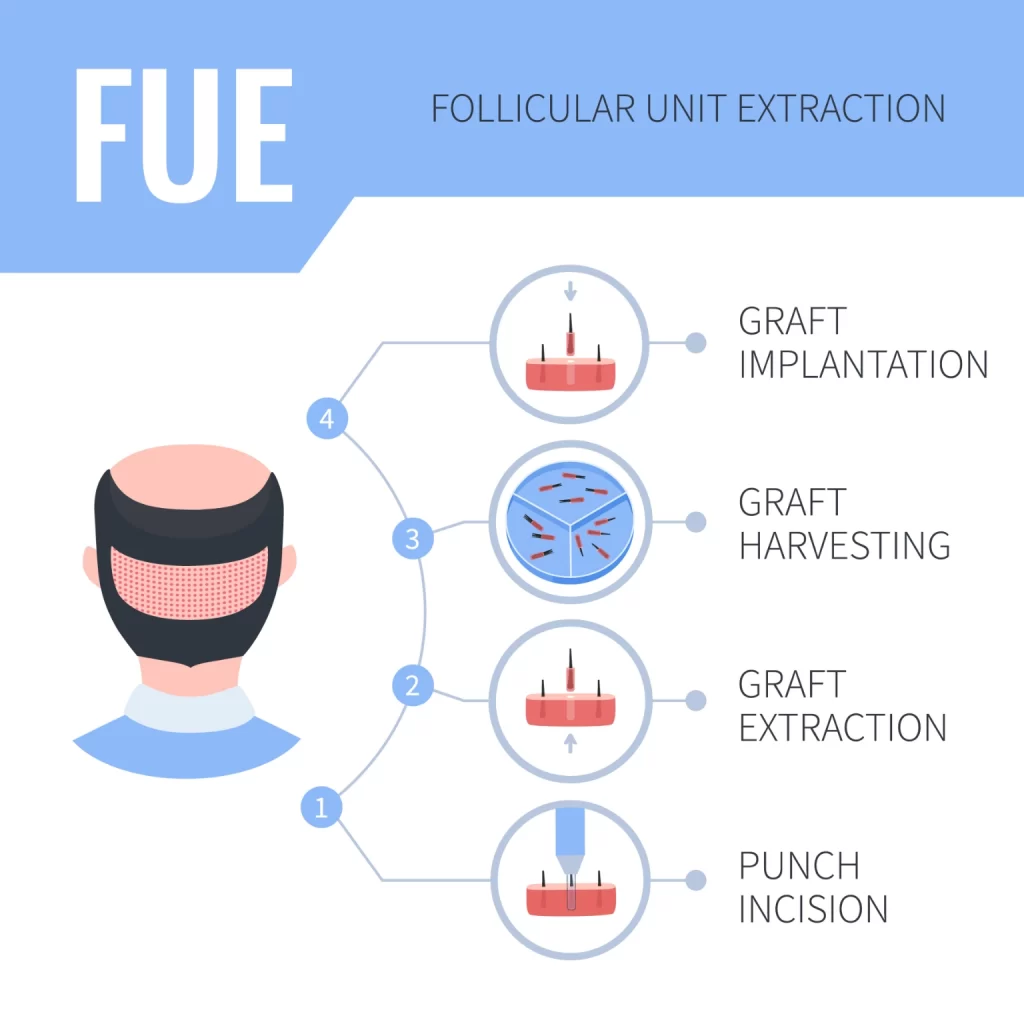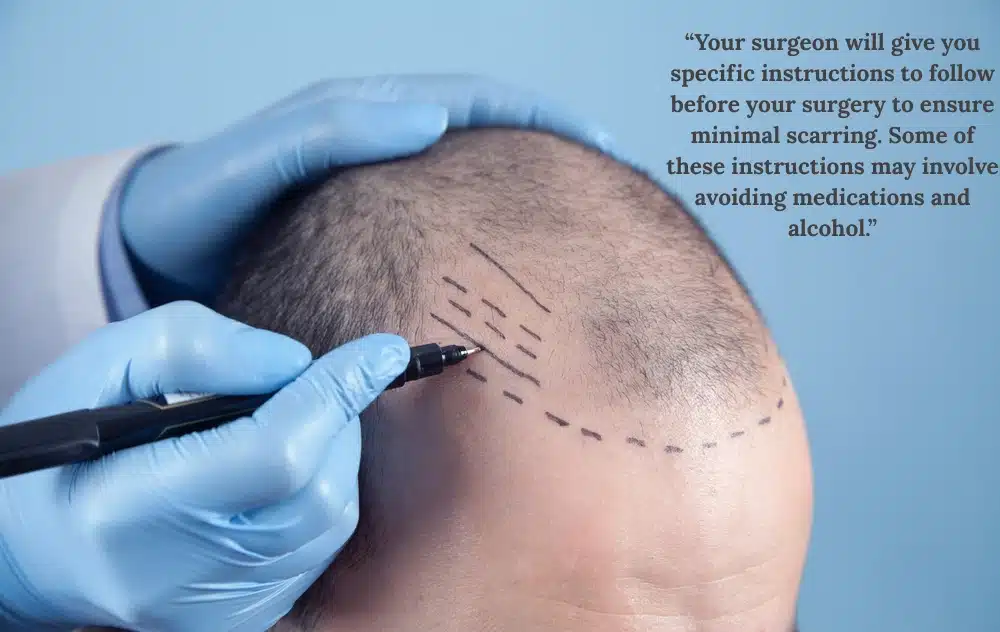Any type of surgery is likely to leave some kind of scar, some more noticeable than others. Follicular unit extraction FUE is a minor surgery that aims to restore a full head of hair to the patient. While the surgical process is minimally invasive, there is still the possibility of scarring.
What Do FUE Scars Look Like?
FUE scars typically look very small and circular, often like small white dots on the scalp. Many people do not even notice them, even when their head is shaved.
Most FUE scarring is nearly invisible to the human eye and is virtually undetectable once the patient grows out their hair (which they can do after the successful hair loss treatment!).
Why Do FUE Scars Occur?
To understand why FUE scars occur, it helps to first understand the hair transplant process.
FUE involves the extraction of hair follicles from the scalp, often using a micro punch tool. This process cuts through the skin, which inevitably causes the development of scar tissue. It results in small, circular wounds on the scalp that turn into tiny, almost unnoticeable white dot-like scars.
What is the Likelihood of Experiencing FUE Hair Transplant Scarring?
Not everyone experiences scar formation following FUE surgery. There’s a chance that you do not notice any scarring after the procedure. However, there is also a possibility you’ll notice small, white dots (the scars), but these tend to fade quickly and are covered by new hair growth.
Compared to FUT (follicular unit transplantation), there is not much need to worry about scarring.
FUE Scars vs. FUT Scars
FUE scarring is minimal, but that’s not always the case with FUT scarring.
FUT uses a different method to complete the hair transplant procedure. It is a type of strip surgery where a thin strip of skin is grafted from the donor area and then transplanted into the balding areas. These transplanted hair follicles then take root and start growing natural hair in the area.
On the other hand, FUE hair transplant surgery extracts individual hair follicles.
That means FUT leaves more noticeable scarring compared to FUE. FUT results in linear scarring on the scalp at the donor area. While it will fade over time and hair does a good job of covering it, this type of scar never fully disappears.
That is why many people opt for FUE rather than FUT, as FUT hair transplant scarring is inevitably more noticeable.
The FUE Healing Process: A Timeline
You do not walk out of a hair transplant clinic with a sudden full head of hair; the surgery requires time and patience for results to show. Here’s a quick timeline of what to expect.
- The First Few Days: This initial recovery period creates scabs around the graft area. You may experience redness, itchiness, tenderness, and mild swelling. [1]
- The First Few Weeks: As the swelling reduces and the scabs fall, you’ll notice shedding hair. It’s a completely normal part of the transplanting hair
- Months One to Three: Your scalp should have healed fully by this point. You might see some visible growth, but not a lot. You may also notice some scarring at this stage, but it should be minimal.
- Months Three to Six: Results start to show through at this stage. You’ll be able to see fine hairs growing through, increasing your hair density.
- Months Six to Twelve: This is when full results are visible. Your hair will be thicker, denser, and look completely natural – after all, it’s from your own scalp and follicles!
Can You Hide a FUE Hair Transplant?
It is recommended that you take some time to rest following a hair transplant. Most surgeons recommend at least one to two weeks off work for the initial recovery process.
To hide a FUE hair transplant following the surgery, you can wear a loose-fitting hat that will cover the scalp area.
Tips for Minimising FUE Scars
Of course, when you go into any surgery, you want to do what you can to reduce scarring as much as possible.
The good news is that there are ways of minimising FUE scarring to the point that you won’t even notice you have any scars!
- Choose the Right Clinic: It is essential to do your research when picking a hair transplant clinic. The right surgeon makes all the difference to the results – not only can a good surgeon ensure better results regarding hair growth, but they can also minimise scarring as much as possible. If you want access to the best FUE hair transplant surgeons, download our excellent hair track app.
- Follow Pre-Op Instructions: Your surgeon will give you specific instructions to follow before your surgery to ensure minimal scarring. Some of these instructions may involve avoiding medications and alcohol. Follow these to a tee!
- Follow Post-Op Instructions: As well as pre-op instructions, your surgeon will also have instructions you must follow after the surgery, such as avoiding strenuous activities.
Avoid Sunlight: The sun can make scars look worse, so avoid UV rays on your scalp, especially in the early days of healing. Wear a hat when in the sun or apply a good SPF – don’t forget to reapply after exercising or swimming.
6 Ways to Hide or Fade FUE Scars
If you already have FUE scars and want to know the best ways to hide or fade them, there are several ways to do so.
- Scalp Micropigmentation
Scalp micropigmentation is a cosmetic tattoo that creates the illusion of short hair. [2] If you have FUE scars, you can get scalp micropigmentation to cover them up – the result would be hair that looks even thicker.
- Adapt Your Hairstyle
Choose a hairstyle that best covers the FUE scarring. It may seem counterintuitive, but shorter hairstyles can better hide these scars, as the short hairs blend better with them. If you prefer longer locks, try a more textured hairstyle with plenty of layers to cover the scalp area (and, in turn, the scars).
- Laser Therapy
Laser therapy can greatly reduce the appearance of scars, flattening them and making them less noticeable. Most people need at least a few laser therapy sessions for results to show through.
- Scalp Camouflage
You can purchase specific products that camouflage scalp scars so they are not visible. It is basically makeup, and the product will blend and conceal the scars with the correct technique.
- Topical Treatments
There are some topical treatments that can improve the appearance of FUE scars over time. They work by hydrating the area and reducing inflammation. Consider products such as silicone gel sheets, retinoid creams, and creams containing onion extract. It’s worth speaking to a dermatologist first.
- Surgical Revision
Surgical revision is an option when the results are not what you wanted. It’s a more invasive process used when patients experience scarring, poor hair follicle quality, and an undesirable hairline design.
Some of these methods are more invasive than others. If you only have minimal scarring, using a scalp camouflage product or switching your hairstyle should be enough. However, if you’ve experienced quite a lot of scarring from a hair transplant, consider something like laser therapy or surgical revision.
Is a FUE Hair Transplant Worth It?
While you might be worried about a FUE hair transplant leaving scars, it’s important to remember that the scarring is typically minimal and the results are more than worth it for many, especially those who choose a reputable clinic and experienced surgeon.
Hair loss is both common and upsetting. Experiencing hair loss at any age can damage your self-confidence, so choosing a method that can give you a full head of hair again is exactly what FUE does.
While FUE scarring is possible, it is usually minimal, and most patients do not have an issue with it. Plus, there are methods you can use to minimise the scarring as much as possible.
Many people with hair loss would agree that some minimal scalp scarring is worth experiencing for full hair growth.
In Summary
A FUE hair transplant involves taking hair follicles from one area of the scalp and transplanting them into another. It’s a minimally invasive surgery that can leave minimal scarring, but it is not noticeable in most cases.
Are you unsure what the results of a FUE hair transplant typically look like? Perhaps you want a visual of the procedure to make your own mind up about whether or not the process is worth it. At Harley Street Hair Clinic, we have a team of excellent surgeons who deliver natural results to patients time and time again. The results speak for themselves; head to our patients gallery to see the incredible work our surgeons perform.
Sources:
- https://www.nhs.uk/tests-and-treatments/cosmetic-procedures/cosmetic-surgery/hair-transplant/
- https://www.webmd.com/skin-problems-and-treatments/hair-loss/what-to-know-scalp-micropigmentation#:~:text=hair%20loss%20itself.-,What%20Is%20Scalp%20Micropigmentation%3F,scalp%2C%20birthmarks%2C%20or%20scars.




